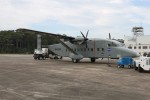
Monday, November 14th, 2016
Researchers from UT Dallas and other universities developed geospatial science methods to help the Egyptian government determine how to avoid flooding in a coastal mountain region. The government wants to develop the area for tourism, but flash flooding and associated hazards have hampered efforts, according to Dr. May Yuan, Ashbel Smith professor of GIS. “We

Monday, October 24th, 2016
A new study using NASA satellite data finds that tide gauges—the longest and highest-quality records of historical ocean water levels—may have underestimated the amount of global average sea-level rise that occurred during the 20th century. A research team led by Philip Thompson, associate director of the University of Hawaii Sea Level Center in the School

Tuesday, October 18th, 2016
Throughout the developing world, access to lifesaving and critical health products is hampered by “the last-mile problem”: the inability to deliver needed medicine from a city to rural or remote locations due to lack of adequate transportation, communication and supply chain infrastructure. To lessen this problem, the Rwandan government will begin using drones to make

Tuesday, October 11th, 2016
As Hurricane Matthew developed into a Category 4 hurricane that pummeled the Caribbean and southeastern United States, killing more than 1,000 people, disrupting electricity and other utilities to hundreds of thousands, and causing billions of dollars in economic damage, many of the world’s satellites and sensors were tuned to the storm, and recorded its path

Wednesday, September 28th, 2016
NASA is conducting low-level aircraft flights measuring greenhouse gases over the U.S. mid-Atlantic region for the CARbon Airborne Flux Experiment (CARAFE), which will measure the exchange of greenhouse gases such as carbon dioxide and methane between Earth and the atmosphere. Water vapor, temperature and vertical wind measurements also will be taken. “The direct measurements of

Tuesday, September 20th, 2016
A laser scanner mounted to ships and submarine vehicles is providing high-resolution images of underwater features, including shipwrecks. The ULS-500 PRO scanner from 2G Robotics uses a high-sensitivity, low-noise sensor to reach ranges previously unattainable with laser scanning, resolving fine-scale dimensional features from distances as far as 20 meters. The system was used offshore during

Thursday, September 8th, 2016
The National Geospatial-Intelligence Agency (NGA) and the National Science Foundation (NSF) released new 3-D topographic maps of Alaska on Sept. 1, 2016, in support of a White House Arctic initiative to inform better decision-making in the area. The 3-D digital elevation models (DEMs) are the first to come from the ArcticDEM project, which was created

Tuesday, August 16th, 2016
Construction of NASA’s Dellingr CubeSat is complete, and the satellite now is ready for environmental testing. Named for the god of dawn in Norse mythology, Dellingr will study the ionosphere—the outer region of Earth’s atmosphere populated by charged particles ionized by incoming solar radiation and magnetospheric particle precipitation. Slightly larger than a cereal box, Dellingr